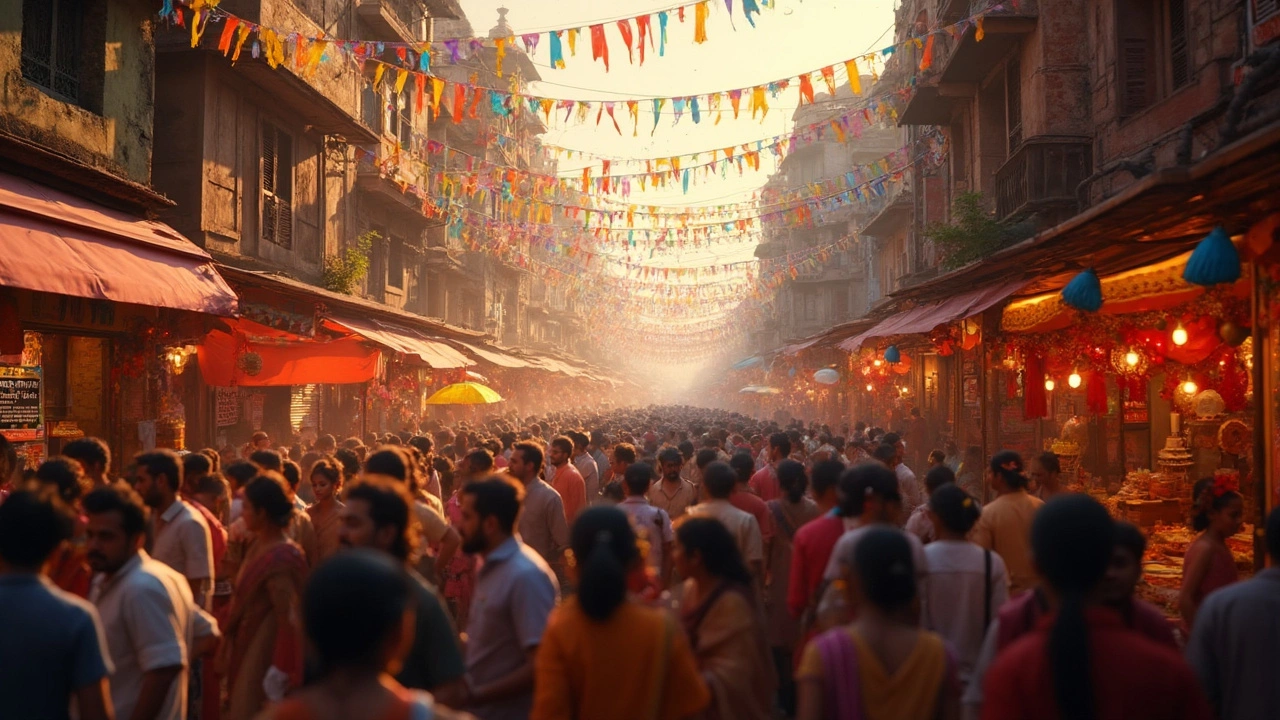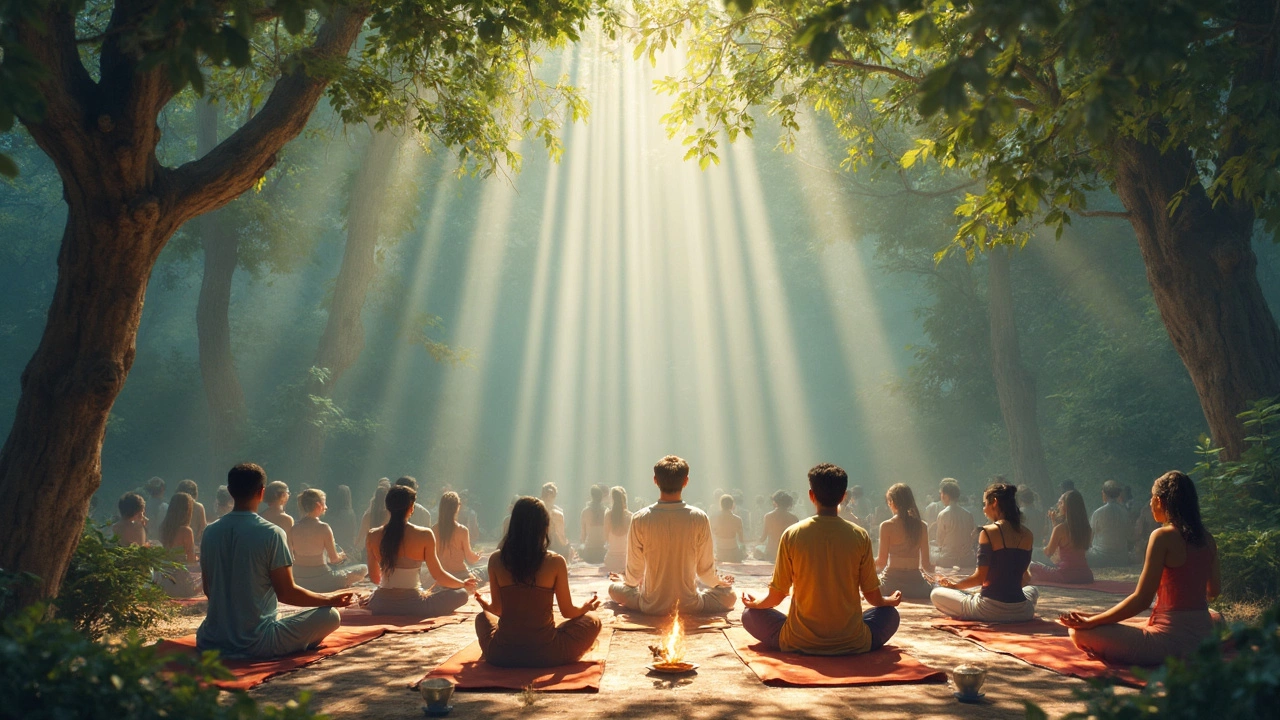Unpacking the Rich Tapestry of Indian Culture
 Apr, 3 2025
Apr, 3 2025
So, you're thinking about diving headfirst into an adventure that's as vibrant as it is diverse? India might just be that exhilarating plunge. Picture this: roaming streets crowded with colors and sounds, munching on spicy street food while your eyes catch a kaleidoscope of saris fluttering in the breeze. India is not just a country—it's an experience that stays with you long after you've left.
India’s culture is like a universe in itself. It boasts a history that rolls back thousands of years, and reflects a blend of influences from countless dynasties, invaders, and travelers who have passed through its lands. Whether you're wandering among the ancient ruins of Hampi or listening to the rhythmic drumbeats of a local festival, India holds stories that echo from its temple walls to its bustling marketplaces.
- A Journey Through India's Rich History
- The Vibrance of Indian Festivals
- Indian Cuisine: A Spice-Laden Adventure
- Arts and Crafts: A Testament to Tradition
- Practical Tips for Cultural Travelers
A Journey Through India's Rich History
Diving into Indian culture means embarking on a journey through layers of history that have shaped not just the country but left an indelible mark on the world. First up, did you know that the Indus Valley Civilization, which dates back to 2500 BCE, is one of the world's oldest urban cultures? It's archaeological sites like Mohenjo-daro and Harappa that give us a peek into advanced city planning and social dynamics of the time.
Fast forward a bit, and you land right in the Golden Age of the Mauryas. This was around the 4th century BCE when India was the epitome of trade and learning. Ashoka the Great is a name you'd hear often; he expanded his empire widely but later became a pacifist, promoting Buddhism across Asia. You can see his edicts inscribed on rocks and pillars, some of which are still in remarkable condition today.
Then there's the cultural renaissance under the Guptas from the 4th to 6th century AD where classic literature like the Mahabharata and Ramayana took their polished forms. Jump to the medieval period, and the Mughal Empire offers a masterclass in art and architecture, bringing masterpieces like the Taj Mahal to life.
If you dig stats, check this out:
| Era | Major Contribution |
|---|---|
| Indus Valley | City Planning |
| Mauryan Empire | Spread of Buddhism |
| Gupta Period | Classical Literature |
| Mughal Empire | Monumental Architecture |
Whether you're exploring ancient scripts or standing in awe of gigantic forts, India's history is all about layers. It's these eras of change and adaptation that have sprinkled the magic dust across its cultural landscape, making India travel feel like flipping through an epic historical novel.
The Vibrance of Indian Festivals
Ever felt the earth thumping with the rhythm of a thousand drums? That's what Indian festivals feel like – a pulsating blend of colors, music, and madness. Indian culture is practically synonymous with its festivals, each one a crazy mix of customs, age-old traditions, and a party you wish would never end.
Take Holi, for instance. Known as the Festival of Colors, Holi is a celebration where friends, family, and complete strangers become artists of chaos, flinging vibrant powders and splashing water. It marks the arrival of spring, and everything about it spells joy and renewal. If you’re in towns like Mathura or Vrindavan during this time, expect to be part of a massive, exhilarating street carnival.
Then there’s Diwali, the Festival of Lights. Imagine homes and streets glowing with the warm light of oil lamps, symbolizing the victory of good over evil. Seen as the most significant festival in India, people celebrate by exchanging sweets, bursting crackers, and enjoying family gatherings. If you’re in Jaipur or Varanasi, the vibrant lights are a breathtaking sight, giving the cities an otherworldly charm.
India’s festive calendar doesn’t stop there. There's Durga Puja in West Bengal, where intricately designed idols of Goddess Durga turn the cities into open-air shrines. And let's not forget Ganesh Chaturthi in Mumbai, famous for its grand processions that take over the streets, each more enthusiastic than the last.
Here’s a quick reminder: During any festival, especially in India, keep your camera ready but also remember to put it down and soak in the moments. Talk to the locals, taste the festive recipes, and above all, be open to the vibrant chaos that comes with it. Explore the festivals as a curious traveler, and you'll find that you're not just witnessing a celebration but becoming a part of the story.

Indian Cuisine: A Spice-Laden Adventure
When it comes to flavor-packed dishes, Indian cuisine truly shines. It's a melting pot of spices, tastes, and traditions that vary from one region to another. Trying Indian food is like taking a flavorful journey from the rich butter chicken of the north to the fiery curries of the south.
One of the best ways to dive into this spice-laden adventure is to hit the local street food stalls. Whether it's the crispy-sweet jalebi or the spicy tang of golgappa, the streets are where you find some of the most exciting bites. Indian cuisine doesn’t shy away from spices, and you’ll often find your taste buds exploring familiar yet exotic flavors simultaneously.
Indian meal staples often include rice, lentils, and bread, but the star players are the spices. You'll frequently encounter cumin, mustard seeds, coriander, and turmeric, creating layers of flavors. Understanding these spices isn’t just a foodie thing; knowing their health benefits might even convince you to stock your pantry back home!
- North Indian cuisine often features dishes like tandoori chicken and naan, with robust, creamy gravies.
- South Indian food leans towards lighter, rice-based dishes such as dosa and sambhar, with a more tangy punch.
- In the west, you might savor the sweet and spicy flavors of Gujarati thalis, while the east offers you a taste of fish delicacies centered around rivers like the Ganges.
Fancy knowing what makes these dishes so incredible? It’s the spice mixes known as masala. These blends are often passed down through generations, showing how deeply rooted food is in Indian culture. Now, remember, spice doesn’t automatically mean heat. It's about the depth of taste and aroma that transforms a simple dish into a culinary delight.
Here’s a little tidbit for trivia night: Did you know India is the world's largest producer of spices? This isn't just a title; the country's contribution is about 75% of the spices traded globally. That's a lot of flavor!
If you're planning a visit, don't just aim for the popular spots. Sometimes, the best-kept secrets are found in hole-in-the-wall joints or even when dining with locals. And trust me, they love to share their food! So, keep an open mind and an empty stomach because Indian cuisine is an adventure you do not want to miss.
Arts and Crafts: A Testament to Tradition
When it comes to Indian culture, the arts and crafts scene is a gold mine of history and creativity. No matter where you go, this country overflows with talent and stories. From intricate textiles to breathtaking sculptures, there's a treasure trove in every corner waiting to be discovered.
First up, we have the textiles. Think about the famous silk sarees of Varanasi. These are no ordinary pieces of clothing—they are handwoven masterpieces that can take up to six months to complete! Crafted with a skill passed down through generations, each saree reflects the rich tapestry of India's culture.
Then there are the sculptures and carvings that leave you awestruck. Head over to the town of Mahabalipuram, and you'll find stone carvings that date back to the 7th century. These aren't just artistic expressions but also narrations in stone of historical and mythological tales.
Ceramics and pottery are just as steeped in tradition. For example, Khurja pottery from Uttar Pradesh stands out with its unique floral patterns and colorful design. This craft allows locals to preserve an age-old art form while providing a livelihood to families depending on this skill for generations.
And let's not forget the paintings. From the folk art of Madhubani to the intricate miniatures of Rajasthan, these canvases capture everything from daily village life to epic legends in vibrant colors and patterns. Each stroke is a story; each frame is a snapshot of times gone by.
If you ever get a chance to visit India, make sure to explore the local bazaars. You’ll find a plethora of items catching your eye and whether you pick up a Phad painting or a handmade carpet, you'll be taking home a piece of Indian tradition and memory.

Practical Tips for Cultural Travelers
Traveling to India can be a whirlwind mix of stunning sights and vibrant experiences, but it can also feel overwhelming if you're not prepared. To truly dive into the cultural richness of Indian culture, a bit of planning can go a long way.
First up, understand the local customs. For example, it's common to remove shoes before entering temples or someone’s home. This small gesture is a sign of respect and will earn you some goodwill.
Next, get ready for the culinary adventure of a lifetime. India is home to some of the world's most renowned cuisine, but the spice levels can be a shock to the system. Start slow and ease into street foods like chai and samosas before attempting fiery curries.
"India is a nation of millions of cultures, and the best way to experience it is to participate and engage rather than just observe," says travel writer Paul Theroux.
Public transport is another aspect where practical tips can save your day. While cities boast modern metro systems, don't shy away from local auto-rickshaws for shorter distances. It’s all part of the urban tapestry and an experience in itself!
- Keep a small amount of cash handy, as many local stalls and transport options won't accept cards.
- Learn a few basic phrases in Hindi. Simple greetings and expressions of thanks can make interactions smoother.
- Respect local dress codes, especially in rural areas and religious sites. Modest clothing is often appreciated and more comfortable for long days out.
Lastly, be ready for unexpected surprises. From a spontaneous Holi celebration in the streets to finding yourself invited to a wedding, India’s charm lies in its unpredictability.
To make your journey efficient, here's a quick look at travel tips:
| Tip | Why It Helps |
|---|---|
| Use prepaid travel cards | Helps manage expenses and reduce reliance on cash |
| Download offline maps | Ideal for navigating areas with spotty internet |
| Travel insurance | Essential for peace of mind during unpredictable adventures |
Cultural tourism in India is a feast for the senses when approached with an open mind and a little preparation—enjoy every moment of it!